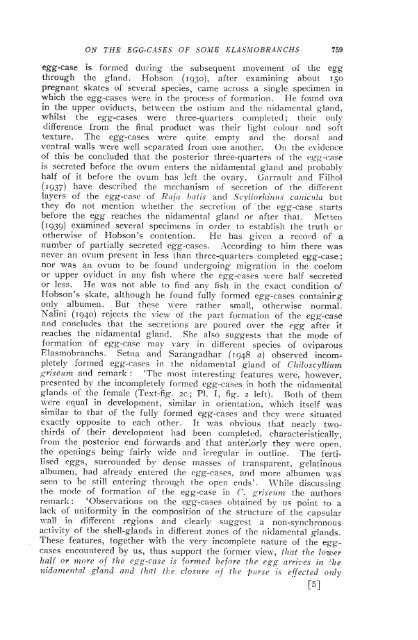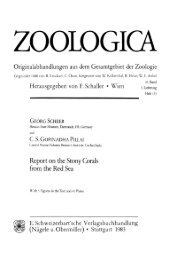observations on the egg-cases of some ovo ... - Eprints@CMFRI
observations on the egg-cases of some ovo ... - Eprints@CMFRI
observations on the egg-cases of some ovo ... - Eprints@CMFRI
Create successful ePaper yourself
Turn your PDF publications into a flip-book with our unique Google optimized e-Paper software.
ON THE EGG-CASES OF SOME ELASAIOBRANCHS<br />
<strong>egg</strong>-case is formed during <strong>the</strong> subsequent movement <strong>of</strong> <strong>the</strong> <strong>egg</strong><br />
through <strong>the</strong> gland. Hobs<strong>on</strong> (1930), after examining about 150<br />
pregnant skates <strong>of</strong> several species, came across a single specimen in<br />
which <strong>the</strong> <strong>egg</strong>-<strong>cases</strong> were in <strong>the</strong> process <strong>of</strong> formati<strong>on</strong>. He found ova<br />
in <strong>the</strong> upper oviducts, between <strong>the</strong> ostium and <strong>the</strong> nidamental gland,<br />
whilst <strong>the</strong> <strong>egg</strong>-<strong>cases</strong> were three-quarters completed; <strong>the</strong>ir <strong>on</strong>ly<br />
difference from <strong>the</strong> final product was <strong>the</strong>ir light colour and s<strong>of</strong>t<br />
texture. The <strong>egg</strong>-<strong>cases</strong> were quite empty and <strong>the</strong> dorsal and<br />
ventral walls were well separated from <strong>on</strong>e ano<strong>the</strong>r. On <strong>the</strong> evidence<br />
<strong>of</strong> this he c<strong>on</strong>cluded that <strong>the</strong> posterior three-quarters <strong>of</strong> <strong>the</strong> <strong>egg</strong>-case<br />
is secreted before <strong>the</strong> ovum enters <strong>the</strong> nidamental gland and probably<br />
half <strong>of</strong> it before <strong>the</strong> ovum has left. <strong>the</strong> ovary. Garrault and Filhol<br />
(1937) have described <strong>the</strong> mechanism <strong>of</strong> secreti<strong>on</strong> <strong>of</strong> <strong>the</strong> different<br />
layers <strong>of</strong> <strong>the</strong> <strong>egg</strong>-case <strong>of</strong> Raja hatis and Scyliorhinus canicula but<br />
<strong>the</strong>y do not menti<strong>on</strong> whe<strong>the</strong>r <strong>the</strong> secreti<strong>on</strong> <strong>of</strong> <strong>the</strong> <strong>egg</strong>-case starts<br />
before <strong>the</strong> <strong>egg</strong> reaches <strong>the</strong> nidamental gland or after that. Metten<br />
(1939) examined several specimens in order to establish <strong>the</strong> truth or -<br />
o<strong>the</strong>rwise <strong>of</strong> Hobs<strong>on</strong>'s c<strong>on</strong>tenti<strong>on</strong>. He has given a record <strong>of</strong> a<br />
number <strong>of</strong> partially secreted <strong>egg</strong>-<strong>cases</strong>. According to him <strong>the</strong>re was<br />
never an ovum present in less than three-quarters completed <strong>egg</strong>-case;<br />
nor was an ovum to he found undergoing migrati<strong>on</strong> in <strong>the</strong> coelom<br />
or upper oviduct in any fish where <strong>the</strong> <strong>egg</strong>-<strong>cases</strong> were half secreted<br />
or less. He was not able to find any fish in <strong>the</strong> exact c<strong>on</strong>diti<strong>on</strong> <strong>of</strong><br />
Hobs<strong>on</strong>'s skate, although he found fully formed <strong>egg</strong>-<strong>cases</strong> c<strong>on</strong>taining<br />
<strong>on</strong>ly albumen. But <strong>the</strong>se were ra<strong>the</strong>r small, o<strong>the</strong>rwise normal.<br />
Nalini (1940) rejects <strong>the</strong> view <strong>of</strong> <strong>the</strong> part formati<strong>on</strong> <strong>of</strong> <strong>the</strong> <strong>egg</strong>-case<br />
and c<strong>on</strong>cludes that <strong>the</strong> secreti<strong>on</strong>s are poured over <strong>the</strong> <strong>egg</strong> after it<br />
reaches <strong>the</strong> nidamental gland. She also suggests that <strong>the</strong> mode <strong>of</strong><br />
foi-mati<strong>on</strong> <strong>of</strong> <strong>egg</strong>-case may vary in different species <strong>of</strong> oviparous<br />
Flasmohranchs. Setna and Sarangadhar (1948 a) observed incompletely<br />
formed <strong>egg</strong>-eases in <strong>the</strong> nidamental gland <strong>of</strong> Chiloscyllium<br />
griseum and remark : 'The most interesting features were, however,<br />
presented by <strong>the</strong> incompletely formed <strong>egg</strong>-<strong>cases</strong> in both <strong>the</strong> nidamental<br />
glands <strong>of</strong> <strong>the</strong> female (Text-fig. 2C; Pl. I, fig. 2 left). Both <strong>of</strong> <strong>the</strong>m<br />
were equal in development, similar in orientati<strong>on</strong>, which itself was<br />
similar to that <strong>of</strong> <strong>the</strong> fully formed <strong>egg</strong>-<strong>cases</strong> and <strong>the</strong>y were situated<br />
exactly opposite to each o<strong>the</strong>r. It was obvious that nearly twothirds<br />
<strong>of</strong> <strong>the</strong>ir development had been completed, characteristically,<br />
from <strong>the</strong> posterior end forwards and that anteriorly <strong>the</strong>y were open,<br />
<strong>the</strong> openings being fairly wide and irregular in outline. The fertilised<br />
<strong>egg</strong>s, surrounded by dense masses <strong>of</strong> transparent, gelatinous<br />
albumen, had already entered <strong>the</strong> <strong>egg</strong>-<strong>cases</strong>, and more albumen was<br />
seen to be still entering through <strong>the</strong> open ends'. While discussing<br />
<strong>the</strong> mode <strong>of</strong> formati<strong>on</strong> <strong>of</strong> <strong>the</strong> <strong>egg</strong>-case in C. griseum <strong>the</strong> authors<br />
remark: 'Observati<strong>on</strong>s <strong>on</strong> <strong>the</strong> <strong>egg</strong>-<strong>cases</strong> obtained by us point to a<br />
lack <strong>of</strong> uniformity in <strong>the</strong> compositi<strong>on</strong> <strong>of</strong> <strong>the</strong> structure <strong>of</strong> <strong>the</strong> capsular<br />
Avail in different regi<strong>on</strong>s and clearly suggest a n<strong>on</strong>-synchr<strong>on</strong>ous<br />
activity <strong>of</strong> <strong>the</strong> shell-glands in different z<strong>on</strong>es <strong>of</strong> <strong>the</strong> nidamental glands.<br />
These features, toge<strong>the</strong>r with <strong>the</strong> very incomplete nature <strong>of</strong> <strong>the</strong> <strong>egg</strong><strong>cases</strong><br />
encountered by us, thus support <strong>the</strong> former view, that <strong>the</strong> lower<br />
half or more <strong>of</strong> <strong>the</strong> <strong>egg</strong>-case is formed before <strong>the</strong> <strong>egg</strong> arrives in he<br />
nidamental gland and that <strong>the</strong> closure <strong>of</strong> <strong>the</strong> purse is effected <strong>on</strong>ly<br />
[5]<br />
759
















